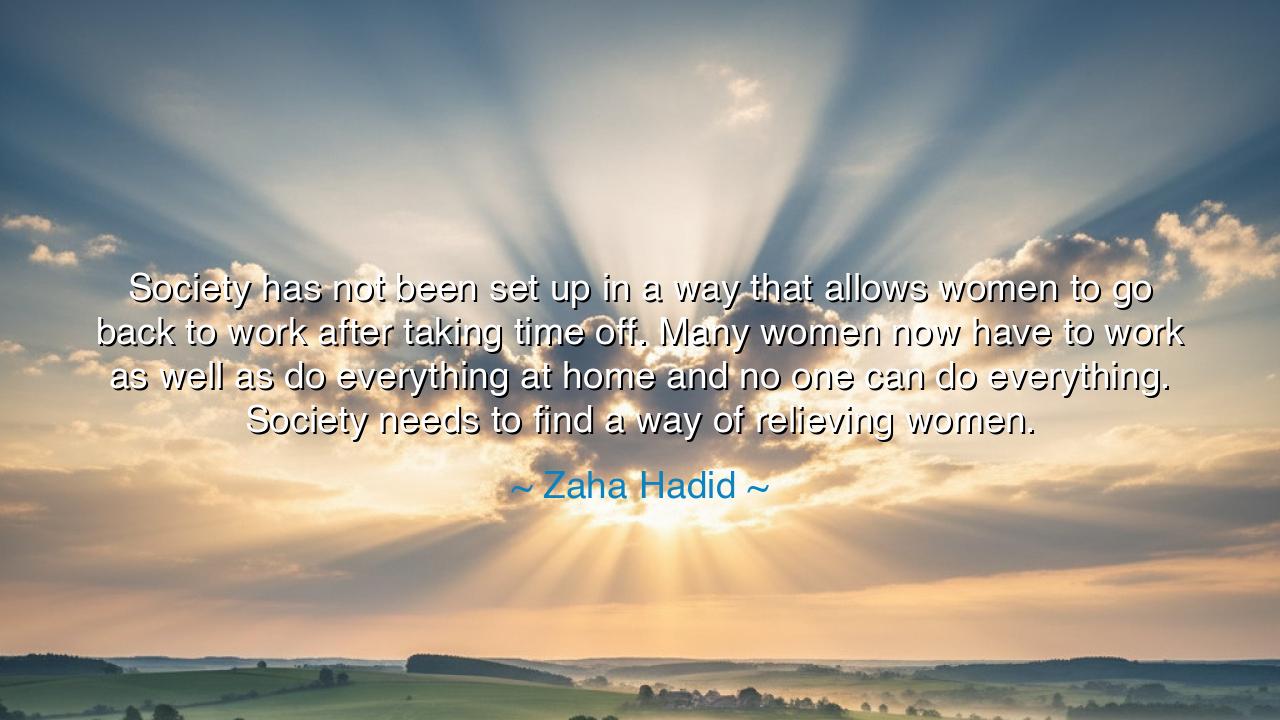
Society has not been set up in a way that allows women to go back
Society has not been set up in a way that allows women to go back to work after taking time off. Many women now have to work as well as do everything at home and no one can do everything. Society needs to find a way of relieving women.






In the words of Zaha Hadid, the architect who shaped cities and defied the limits of form, we hear not only the voice of a designer, but the cry of a visionary for justice: “Society has not been set up in a way that allows women to go back to work after taking time off. Many women now have to work as well as do everything at home and no one can do everything. Society needs to find a way of relieving women.” These words, spoken from the depths of experience, are not merely a reflection on gender — they are a diagnosis of imbalance, a call to restructure the very foundations upon which modern civilization rests. For Hadid, who built towers of steel and glass that seemed to defy gravity itself, understood that the greatest structures of all — those of society — must also be reimagined if they are to endure.
To the ancients, the harmony of any order — be it the state, the family, or the cosmos — depended upon balance. The Greeks called this principle sophrosyne, the art of temperance and proportion. When any force in the universe takes more than its share, chaos follows. In her quote, Hadid names the imbalance that modern life has imposed upon women: they are asked to be creators in two worlds — the world of work and the world of home — without the support of structure or community. This double burden is not natural; it is a design flaw in the architecture of society itself. And who better than an architect to recognize a faulty design?
Hadid’s own life was a testament to this struggle. Born in Baghdad, she rose through a world that was not built to accommodate her — a woman, an Arab, a visionary in a field dominated by men. She shattered convention not through rebellion, but through creation. Each building she designed — from the fluid curves of the Heydar Aliyev Center to the soaring forms of the Guangzhou Opera House — seemed to reject rigidity itself, as if whispering that structures, like societies, must learn to bend if they are to endure. Yet even she, with her success, could see that for many women, the path to return after motherhood or pause was blocked — not by lack of talent, but by the walls of expectation.
Consider the ancient tale of Penelope, wife of Odysseus, who waited twenty years for her husband’s return. Each day she wove a tapestry, and each night she unraveled it, keeping her world in order while the world of men moved forward without her. In that story, we find a haunting metaphor for Hadid’s lament: even now, women are expected to weave the fabric of family while being denied the freedom to rejoin the realm beyond it. Like Penelope, they are caught in a cycle of endless giving, their creativity confined to the domestic sphere. Hadid’s words break that cycle, demanding that society itself evolve — that it build new pathways where women can create without constraint.
Her statement also carries a deeper wisdom: that no civilization can thrive when half its population bears a disproportionate burden. The ancients spoke of the state as a body — if one limb is weakened, the whole cannot stand upright. In the same way, a society that refuses to support women’s full participation is a structure leaning toward collapse. To “relieve women,” as Hadid says, is not charity but necessity. It is the act of restoring balance, of allowing human potential — both masculine and feminine — to move in harmony once again.
But how shall this relief come? The lesson here is not one of complaint, but of transformation. Just as Hadid reshaped the skylines of cities, so must we reshape the architecture of daily life. Workplaces must bend to the rhythms of life rather than demand that life be sacrificed upon the altar of labor. Families must share the load of care, for nurturing is not a woman’s duty alone but a human inheritance. Governments and communities must invest not in symbols of equality, but in its infrastructure — childcare, parental leave, flexible work, and respect for the creative pulse of every life. These are not luxuries; they are the pillars of a just society.
And so, let us carry forward Zaha Hadid’s teaching: that the structures we inhabit, both physical and social, must serve the living, not constrain them. No one can do everything, as she reminds us — but together, we can design a world where all may flourish without breaking under the weight of expectation. Just as Hadid’s architecture curved and flowed, unbound by straight lines, so too must our systems of labor and love find new forms — flexible, inclusive, alive. Let us build, as she did, not from imitation of the old, but from the courage to imagine the new. For when society learns to relieve women, it will at last relieve itself — and in that balance, both beauty and wisdom will dwell.






AAdministratorAdministrator
Welcome, honored guests. Please leave a comment, we will respond soon